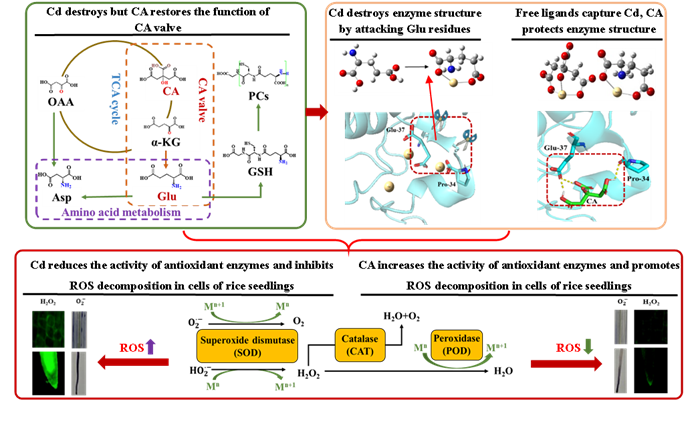Research Reveals the Molecular Mechanism of Citrate in Alleviating Cd Induced Oxygen Free Radical Burst in Rice Cells
Recently, the innovation team of heavy metal ecotoxicology and pollution remediation at Agro-Environmental Protection Institute, Ministry of Agriculture and Rural Affairs revealed the molecular mechanism of exogenous citrate supplementation to alleviate Cd induced hydrogen peroxide and superoxide anion outbreaks in rice cells, providing a theoretical basis for the prevention and control of plant abiotic stress. The relevant research results are published in the journal of Chemosphere.
Cd stress usually leads to excessive accumulation of oxygen free radicals in plant cells, leading to membrane lipid peroxidation and structural damage, and even disrupting normal physiological and metabolic activities of plants, affecting their growth and development. Therefore, reducing Cd accumulation in rice and maintaining cell redox homeostasis are urgent scientific issues that need to be addressed to ensure food safety production.
This research systematically explores the pathway and mechanism of exogenous citrate in alleviating Cd induced excessive accumulation of oxygen free radicals in rice cells. Research has found that the disruption of citrate-glutamate regulation process and the destruction of antioxidant enzyme structure caused by Cd stress are important reasons for the burst of superoxide anions and hydrogen peroxide in rice cells. The results showed that exogenous supplementation of citrate can improve the heavy metal chelating ability of rice cells, restore the normal metabolic function of citrate-glutamate, avoid the production of excessive oxygen free radicals from the source, and form stable hydrogen bonds between citrate and antioxidant enzymes to avoid Cd damage to enzyme structures, improve the activity of antioxidant enzymes, and alleviate Cd induced oxygen free radical explosions in rice cells.
The pathway and mechanism of exogenous citrate in alleviating Cd induced excessive accumulation of oxygen free radicals in rice cells
This work has been jointly by the National Key Research and Development Program of China, the National Natural Science Foundation of China, and Funds for Science and Technology Innovation Project from the Chinese Academy of Agricultural Sciences.
Link: https://doi.org/10.1016/j.chemosphere.2023.138511
Contact: tzfelicity@163.com

-
 Apr 18, 2024Opening Ceremony of the Training Workshop on Wheat Head Scab Resistance Breeding and Pest Control in Africa Held in CAAS
Apr 18, 2024Opening Ceremony of the Training Workshop on Wheat Head Scab Resistance Breeding and Pest Control in Africa Held in CAAS -
 Apr 03, 2024IPPCAAS Co-organized the Training Workshop on Management and Application of Biopesticides in Nepal
Apr 03, 2024IPPCAAS Co-organized the Training Workshop on Management and Application of Biopesticides in Nepal -
 Mar 28, 2024Delegation from the School of Agriculture and Food Science of University College Dublin, Ireland Visit to IAS, CAAS
Mar 28, 2024Delegation from the School of Agriculture and Food Science of University College Dublin, Ireland Visit to IAS, CAAS -
 Mar 25, 2024Director of World Food Prize Foundation visited GSCAAS
Mar 25, 2024Director of World Food Prize Foundation visited GSCAAS -
 Mar 20, 2024Institute of Crop Sciences (ICS) and Syngenta Group Global Seeds Advance Collaborative Research in the Seed Industry
Mar 20, 2024Institute of Crop Sciences (ICS) and Syngenta Group Global Seeds Advance Collaborative Research in the Seed Industry
